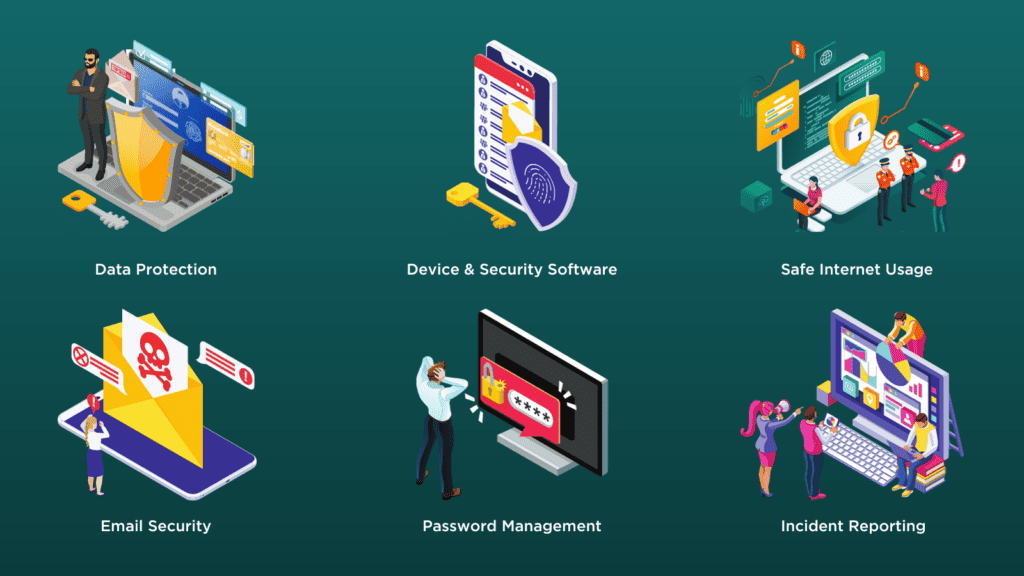The Importance Of Cyber Security Awareness Training For Employees
Cyber security awareness training for employees is a way of educating your staff about the risk of cyber crime and subsequently reducing the threat of cyber attacks.
There are several ways that cyber security awareness training can delivered. Therefore, this guide will break the subject down, so that you’re equipped with the knowledge you need to provide your workforce with the correct cyber security training to keep your organisation safe.
What is cyber security awareness training?
Cyber security awareness training is a strategy that can be used by businesses to mitigate the risk their users pose in relation to cyber crime.
Designed to help educate employees, so that they understand the role they play in cyber security, effective security awareness training can help secure your business against a ranch of breaches. It can help your staff identify cyber attacks they may encounter such as phishing emails or malware, as well as teach them how to react to a cyber security incident.
Cyber security awareness training for employees can be delivered in person or online, although the best approach is often multi-faceted and will take the needs, demands and specific circumstances of your business into account. For example, if your employees take laptops home with them, the security risks will be very different compared to a business with desktop computers that remain secure inside a centralised office. The context of your business will dictate whether you’re more or less likely to experience a particular type of attack.
Effective cyber security training will often analyse the risks and best practices using a combination of simulated breaches and traditional employee learning. This means employees with different learning styles will be able to understand what is being taught. It also ensures the content is interesting which will mean your employees are kept engaged and interested.
Why is cyber security awareness training important?
Cyber security awareness training is important because it protects businesses against cyber attacks and data breaches. Specifically, employee security training can assist with:
- Preventing data breaches and phishing attacks
- Implementing a security-aware culture within your business
- Ensuring your network security and IT infrastructure remains secure and robust
- Giving both your employees and your customers’ confidence
- Achieving compliance standards and regulatory obligations
Cyber security is more important than a simple tick-box exercise. It should be ingrained in the culture of your business. The best way to sew a security-aware culture into the fabric of your organisation is to start from the top down. If you take cyber security seriously, then the rest of your business should follow suit.
To begin, it’s important that cyber security is discussed openly between employees and management. By making it real, your employees will feel comfortable discussing any concerns, reporting incidents and sharing challenges they may be facing.
If your employees feel like they may be ridiculed for asking a question or reprimanded for making a mistake, then there’s a strong chance they’ll conceal any security issues. It’s much better to have an over-zealous employee than one who is complacent. This is because complacent employees are a much bigger risk to your organisation than those openly discussing the security issues they’re facing.
How do you train employees for cyber security?
There are a range of ways you can train your employees in cyber security. The best method for your business will be determined by the nature of your workforce, and other factors such as where they are located, and the budget you may have.
Below are some of the different ways your business could train you staff in cyber security awareness.
Awareness Campaigns: Run regular awareness campaigns to educate your employees about common cyber threats and how to recognise them. Regular awareness campaigns may include workshops, newsletters, posters or videos that inform your staff about the latest cybersecurity risks and trends.
Awareness campaigns can be a good way to spread information quickly, but if the content doesn’t remain interesting, powerful, or never changes, employees may start to ignore future efforts, mitigating their effectiveness.
Simulated Phishing Exercises: Simulated phishing exercises are a cyber security service provided by many IT firms and will test your employees’ ability to spot phishing emails and potentially malicious content. This software can help employees recognise the nuances of phishing attempts and understand the importance of reporting suspicious emails.
Simulated phishing exercises are a good way to build awareness around the vulnerability of emails, but it’s important that any employees struggling with the exercises aren’t made to feel stupid for doing so. Those that click on simulated attempts should be encouraged and educated and certainly not punished.
Role-Based Training: You can tailor cyber security training specifically to employees’ roles, focusing on the precise security processes relevant to their job. Tailoring training ensures that employees learn only what is relevant to their job, making the information more applicable and practical.
By keeping your awareness training specific, it is easier to keep employees engaged as they will be able to see the relevance to their every day and how their precise actions will have an impact on the cyber security of the business.
Hands-On Workshops: Organisations such as the South West Regional Cyber Crime Unit will often offer public hands-on workshops to provide information about the different types of security services available and to teach practical skills such as secure password management. These can often be done internally or externally, depending on the training provider and whether they’re a for-profit organisation or otherwise.
Interactive workshops allow employees to practice secure behaviours, see the real implications of their actions or otherwise and are a more engaging way in which to deliver awareness training. By investing time, money and resources into your security training it also illustrates how seriously your organisation is taking cyber security, helping to build a security conscious culture across the work force.
Regular Updates: Cyber security training is only as effective as it remains relevant. Therefore, it is critical that your business provides ongoing training to keep employees informed about evolving threats and best practices. This should foster a culture of continuous cyber security learning.
Ongoing training might involve quarterly or annual refreshers, webinars, or updating versions of any of the above to ensure employees stay up to date with cyber security best practices and changing threats.
What type of training is required for cyber security?
Once you have decided the right way to deliver the cyber security awareness training for your employees, it’s important to consider what content it is necessary to teach your employees about.
Again, this will vary based on your organisation, but you will want to consider some or a mix of the following:
Basic Cyber Security Awareness: All employees should receive fundamental training on recognising common cyber threats such as phishing emails, malware, and social engineering. This includes understanding how to identify suspicious links and attachments in emails.
Password Management: Training should cover the importance of strong, unique passwords and the need to change them regularly. Employees should also learn about the benefits of multi-factor authentication and any specific password management rules or practices your organisation enforces.
Safe Internet Usage: Employees need to understand the dangers of visiting untrusted websites and downloading software from unofficial sources. They should be aware of the risks of public Wi-Fi and know how to secure their online activities. Use of a VPN should be taught to all employees that require access to the internet away from your centralised network.
Data Protection: Employees should learn how to handle sensitive data securely, both in digital and physical forms. They must understand the organisation’s data protection policies and be aware of any changes to internal policy or the law.
Email Security: Employees should be educated on how to use email securely, as well as how to recognise phishing attempts and other malicious emails. They should be taught how to encrypt emails where necessary and when it should be used.
Device and Software Security: Training should include information about keeping devices and software up-to-date, and how to secure mobile devices or laptops away from the office. Multi factor authentication should again play a large role here.
Incident Reporting: It is imperative that employees know when they need to report an incident, how to report such security incidents, to who, and what information they require. It must be stressed that any breaches or vulnerabilities are reported quickly, whilst it is the responsibility of management to ensure there is not a fear culture around reporting.
Why do we need to train employees on cyber security?
Training employees on cyber security is essential for several reasons. First and foremost, employees are often the weakest link in an organisation’s security. Many cyber attacks, such as phishing and social engineering, target individuals within a company to gain unauthorised access or to compromise sensitive data. Proper training empowers employees to recognise and respond to these threats, significantly reducing the risk of successful attacks and subsequent damage to the organisation.
As the threat landscape continually evolves, it is crucial to keep employees updated on the latest cyber risks and best practices. Without ongoing training, employees may become complacent, making the organisation more vulnerable to emerging threats. Regular training helps create a culture of vigilance and ensures that your company’s security remains effective.
Cyber security training not only safeguards an organisation’s digital assets and data though. It also helps protect its reputation and financial well-being. Data breaches and cyber incidents can lead to significant financial losses, legal liabilities, and damage to an organisation’s reputation. By investing in employee cybersecurity training, businesses can mitigate these risks, demonstrate a commitment to data protection, and enhance their overall image amongst customers and others in the business community.
How effective is cyber security training?
Cyber security awareness training for employees can take a significant amount of time and resource away from an organisation. This understandably may leave you wondering whether it is worth committing to such training.
Naturally the impact of security awareness training can vary depending on several factors. A key factor will be the quality of the training itself. Well-designed training that is up to date, tailored to an organisation’s specific needs and covers a broad range of topics is more likely to be effective, than training that is not.
The other crucial element for effectiveness will be employee engagement. When employees actively participate in cyber security training and take it seriously, the training becomes more impactful. The willingness of employees to apply what they’ve learned to their daily work is key to building a strong and secure organisation.
Regular updates are also essential for making your training effective. Cyber threats are constantly evolving, and training programs must continue to address new risks and vulnerabilities. Outdated training may not prepare employees for current threats, leaving your business vulnerable.
Simulated phishing exercises can serve as a measure for training effectiveness. If employees consistently identify and report simulated phishing attempts, it is a positive indicator of the training’s impact and that the awareness across your employees is good.
Most importantly, creating a culture of security awareness within the organisation will significantly enhance the effectiveness of your training. When cyber security is integrated into an organisation’s values and practices, employees are more likely to adopt secure behaviours in their daily work, benefiting the entire business.
Cyber security services from Acronyms IT Support
At Acronyms IT Support we have provided businesses of all sizes, across a range of industries, with specific and tailored cyber security services to help keep their business secure.
We will often work with these businesses to ensure that they have a rigorous cyber security awareness plan in places that ensures their employees are well educated in cyber security.
If you’d like to discuss how Acronyms may be able to help secure your organisation and keep it protected from the threat of cyber attack, you can book a free no-obligation consultation today.
Alternatively, you might find the following resources useful:
Our Cyber Security Services
Lang Town & Country Case Study






